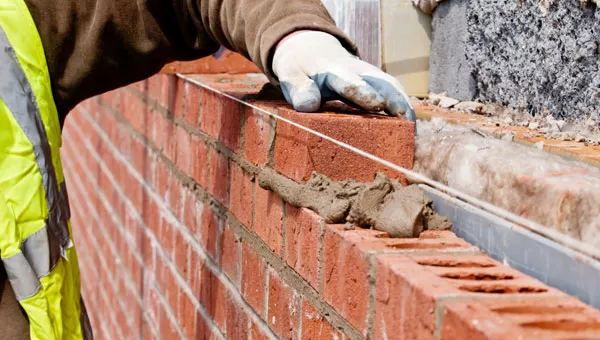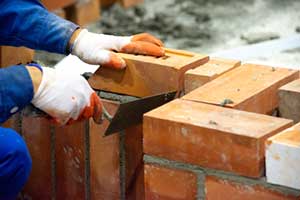Opening the Tricks of Sustainable Masonry Building Practices for Eco-Friendly Buildings
In the realm of contemporary construction, the pursuit of sustainable techniques has actually come to be vital. Among the myriad strategies to green structure, sustainable stonework building and construction sticks out as a time-tested and resilient technique that holds a riches of untapped possibility. From the selection of materials to cutting-edge building and construction techniques, the secrets to accomplishing sustainability within masonry building and construction are multifaceted and interesting. By exploring the advantages, products, methods, and future trends of sustainable masonry, a deeper understanding of just how these methods can form the future of environment-friendly structures arises.
Benefits of Sustainable Stonework Construction
Embracing lasting masonry construction methods not only reduces environmental effect however likewise offers long-term economic benefits to contractors and neighborhoods. By making use of products like recycled bricks, obstructs, and stones, builders can significantly decrease the carbon footprint of their tasks while promoting source efficiency. In addition, sustainable stonework building techniques, such as correct insulation and thermal mass buildings, can enhance power effectiveness within buildings, leading to minimized operational expenses with time.
In addition, the toughness and resilience of masonry frameworks add to long-term financial benefits. Buildings created making use of sustainable masonry methods often require less upkeep and repair, equating to set you back savings for home builders and homeowner. The long life of stonework products additionally ensures that structures stay secure and secure, minimizing the demand for frequent restorations or substitutes.
Eco-Friendly Stonework Materials
Using environment-friendly masonry materials is a crucial action in the direction of enhancing the sustainability of building methods and lessening environmental influence while maximizing lasting economic advantages. Sustainable stonework materials are sourced, produced, and used in a manner that decreases overall ecological effect. Sustainable concrete obstructs include recycled aggregates and might feature enhanced insulation residential properties, contributing to power performance in structures.
Furthermore, all-natural products like adobe, rammed earth, and straw bundles offer outstanding thermal mass homes, decreasing the need for heating and cooling down energy. These materials are usually in your area readily available, advertising local economic climates and reducing transportation-related carbon emissions. By choosing eco-friendly stonework products, construction jobs can substantially decrease their environmental impact and add to the production of much healthier, more sustainable constructed settings.
Energy-Efficient Stonework Strategies
Energy performance plays an important function in improving the sustainability of masonry construction practices. By carrying out energy-efficient masonry techniques, contractors can dramatically reduce the overall power consumption of a structure, leading to lower functional costs and a smaller ecological footprint. One essential energy-efficient stonework method is the reference usage of thermal mass, which involves integrating thick materials like concrete or brick into the structure's framework to take in and save warmth. This helps manage interior temperature levels, reducing the requirement for mechanical heating and cooling down systems.

Advancements in Sustainable Stonework
Recent innovations in sustainable masonry techniques have caused cutting-edge strategies that are improving the building market. One such advancement is the advancement of self-healing concrete, which uses bacteria installed within the concrete to recover fractures autonomously. This innovation not just minimizes maintenance prices but additionally boosts the durability of masonry structures, contributing to their sustainability.
An additional noteworthy technology is making use of recycled aggregates in masonry construction - masonry contractor. By incorporating products such as smashed ceramic waste or recycled glass right into concrete mixes, builders can lower the ecological impact of building jobs while keeping structural stability. This technique not just draws away waste from garbage dumps but also conserves natural deposits, making it a vital advancement in lasting masonry building
Furthermore, the combination of digital style devices, such as Building Info Modeling (BIM), is reinventing the way masonry structures are planned and constructed. BIM enables for more precise calculations, decreased product wastefulness, and enhanced energy performance, inevitably leading to more lasting structure techniques. These technologies collectively signify an appealing future for sustainable masonry building and construction in the period of eco-friendly structures.
Future Trends in Masonry Sustainability
With the ingenious strides reinforced cement concrete made in lasting stonework practices, stamped concrete gray the future fads in masonry sustainability are poised to further revolutionize the building industry. Among the key trends forming the future of masonry sustainability is the boosted combination of technology. Advancements such as Building Info Modeling (BIM) and digital reality simulations are being utilized to optimize stonework construction procedures, resulting in decreased material waste and improved power effectiveness in structures.
In addition, the advancement of unique sustainable products is readied to play a substantial role in improving the eco-friendliness of masonry building and construction. masonry contractor. Innovations like self-healing concrete, recycled aggregates, and bio-based binders are acquiring grip for their capacity to lessen ecological impact while keeping architectural honesty

Final Thought
Finally, sustainable masonry building practices offer various advantages for green structures. By using environmentally friendly products and energy-efficient methods, masonry can add to a much more lasting constructed environment. Innovations in sustainable masonry are continuously being established to additionally boost the environmental efficiency of structures. Looking towards the future, the trend of masonry sustainability is anticipated to expand, leading to even more ecologically friendly and energy-efficient construction techniques in the years to come.